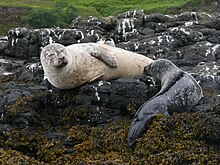
Back Fauna d'Escocia AST Fauna d'Escòcia Catalan Fauna Schottlands German Fauna de Escocia Spanish Faune de l'Écosse French Fauna Škotske Croatian Շոտլանդիայի կենդանական աշխարհ Armenian Fauna Skotlandia ID Фауна Шотландии Russian Fauna Škotske Serbo-Croatian
| Part of a series on the |
| Biodiversity of Scotland |
|---|
 |

The fauna of Scotland is generally typical of the northwest European part of the Palearctic realm, although several of the country's larger mammals were hunted to extinction in historic times and human activity has also led to various species of wildlife being introduced. Scotland's diverse temperate environments support 62 species of wild mammals, including a population of wild cats, important numbers of grey and harbour seals and the most northerly colony of bottlenose dolphins in the world.[1][2][3]
Many populations of moorland birds, including the black and red grouse live here, and the country has internationally significant nesting grounds for seabirds such as the northern gannet.[4] The golden eagle has become a national icon,[5] and white-tailed eagles and ospreys have recently re-colonised the land. The Scottish crossbill is the only endemic vertebrate species in the UK.[6][7][8]
Scotland's seas are among the most biologically productive in the world; it is estimated that the total number of Scottish marine species exceeds 40,000.[9] The Darwin Mounds are an important area of deep sea cold water coral reefs discovered in 1998. Inland, nearly 400 genetically distinct populations of Atlantic salmon live in Scottish rivers.[10] Of the 42 species of fish found in the country's fresh waters, half have arrived by natural colonisation and half by human introduction.
Only six amphibians and four land reptiles are native to Scotland, but many species of invertebrates live there that are otherwise rare in the United Kingdom (UK).[11] An estimated 14,000 species of insect, including rare bees and butterflies protected by conservation action plans, inhabit Scotland. Conservation agencies in the UK are concerned that climate change, especially its potential effects on mountain plateaus and marine life, threaten much of the fauna of Scotland.[12]
- ^ Thompson, P.M.; Corkrey, R.; Lusseau, D.; Lusseau, S.M.; Quick, N.; Durban, J.W.; Parsons, K.M.; Hammond, P.S. (2006). "An assessment of the current condition of the Moray Firth bottlenose dolphin population". Scottish Natural Heritage Commissioned Report (175). Perth.
- ^ Matthews (1968) p. 254.
- ^ "Mammals". Scottish Natural Heritage. Archived from the original on 30 December 2006. Retrieved 1 January 2007.
- ^ Fraser Darling and Boyd (1969) pp. 7, 98–102.
- ^ Benvie (1994) p. 12.
- ^ In the past, this claim has been made on behalf of other species such as the red grouse (now considered to be a sub-species of willow ptarmigan) and Irish stoat (Mustela erminea hibernica), also now considered to be a sub-species of stoat. Loxia scotica's position as a true species is a matter of debate but the current consensus is that it does have this status (see for example Miles and Jackman (1991) pp. 21–30 and Benvie (2004) p. 55.) The position of the freshwater fish the vendace Coregonus vandesius is disputed, with many authorities considering it to be a synonym of Coregonus albula.
- ^ Adams, William Mark (2003) Future Nature. British Association of Nature Conservationists p. 30. Retrieved 14 July 2009. This source lists the UK's endemic species as being "14 lichens, 14 bryophytes, 1 fern, 21 higher plants, 16 invertebrates and 1 vertebrate (the Scottish crossbill)."
- ^ Perhaps because endemic vertebrates are all but absent from the UK neither SNH nor JNCC appear to provide a definitive "list" but it is clear that the Scottish crossbill is the only endemic bird, (Gooders (1994) p. 273. and "Scottish Crossbill: Loxia Scotica" (pdf) JNCC. Retrieved 7 July 2009.) and that there are no endemic freshwater fish (Maitland, P. and Lyle A.A. (1996) "Threatened freshwater fishes of Great Britain" in Kirchofer, A. and Hefti, D. (1996) Conservation of Endangered Freshwater Fish in Europe. Basel. Birkhauser.) or mammals ("The British Mammals list" Archived 28 July 2011 at the Wayback Machine ppne.co.uk. Retrieved 7 July 2009.) in Britain. There are too few amphibians and reptiles native to the UK for there to be any doubt that no endemic species exist. The position is implied, although not stated by SNH in their Information and Advisory Note Number 49 "Priority species in Scotland: animals" Archived 9 November 2016 at the Wayback Machine Retrieved 7 July 2009. See also Myers, Norman (2003) "Conservation of Biodiversity: How are We Doing?" Archived 16 July 2011 at the Wayback Machine (pdf) The Environmentalist 23 pp. 9–15. Retrieved 7 July 2009. This publication confirms there is only one "endemic non-fish vertebrate species" in the British Isles, although it fails to identify the species concerned.
- ^ "Inshore Fisheries in Scotland". The Scottish Government. Archived from the original on 7 June 2011. Retrieved 24 August 2008.
- ^ Cite error: The named reference
sefishwas invoked but never defined (see the help page). - ^ Miles and Jackman (1991) p. 48.
- ^ See for example Johnston, I. (29 November 2006) "Sea change as plankton head north'". Edinburgh. The Scotsman. This report quotes James Lovelock's concern that global warming will "kill billions" of people over the coming century.